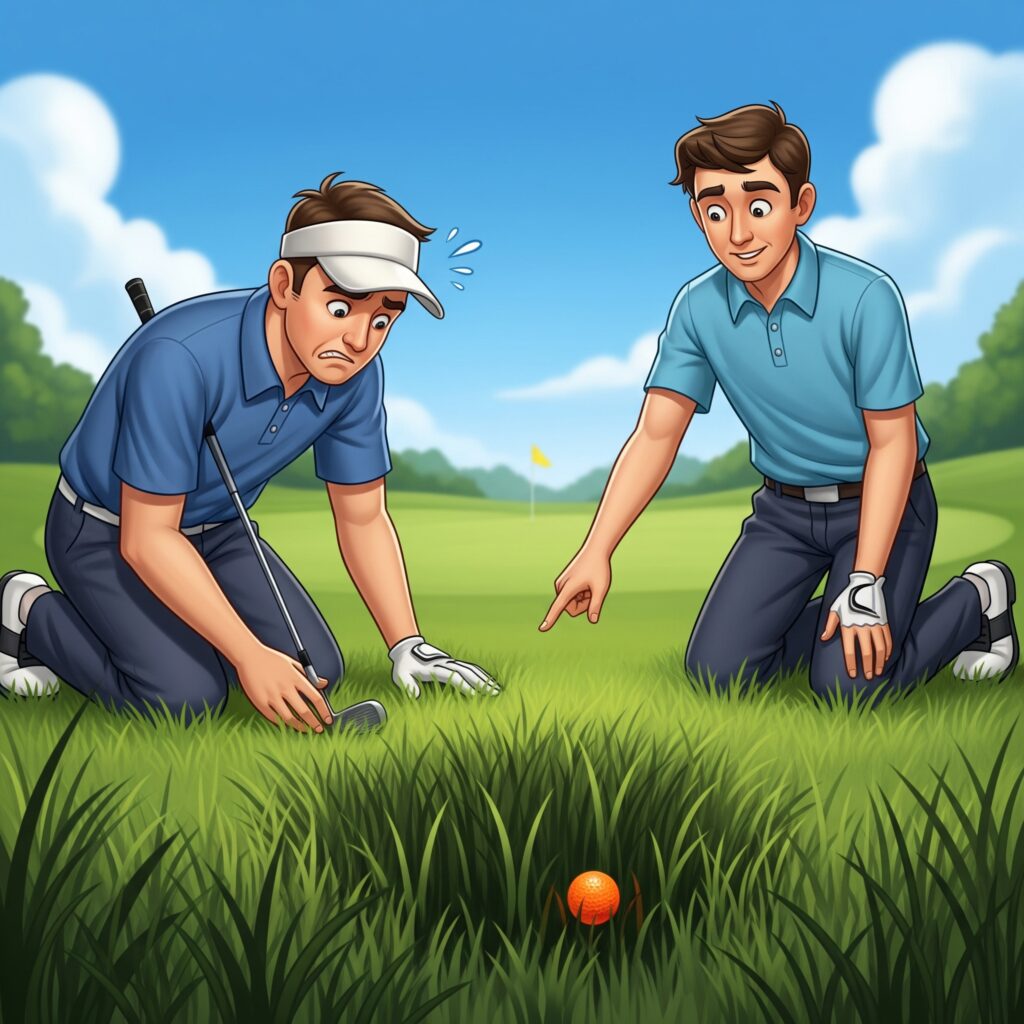How to Stop Losing Golf Balls
The frustration of watching your golf ball go into the rough, or worse, a water hazard, is a familiar pain for any golfer.
The constant search for how to stop losing golf balls can ruin your game and your wallet.

This guide offers five simple and easy-to-implement tips to keep more golf balls in play, allowing you to spend less time searching for a lost ball and more time on the golf course.
Our ultimate goal is to help you stop losing golf balls and improve your play.
TIP #1
Master Your Ball Tracking
One of the simplest and most effective ways to prevent losing golf balls is to watch your shot. This seems obvious, but many golfers look up too quickly and lose sight of the ball’s flight.
Use a landscape feature, such as a tree, shrub, or path, as a reference point to help you track the ball more accurately.
After hitting the golf ball, keep your head still through impact and follow the ball’s entire flight with your eyes. Watch it until it stops.
I’ve found that just taking an extra second or two to watch my golf ball saves me minutes of searching later. Even on an off-center shot, watching the ball will narrow down your search area.
When searching, keep your vision broad to avoid tunnel vision and improve your ability to see the ball. This is the most overlooked yet most effective tip to keep your ball in play.
Having a golf partner can also help confirm where the ball landed and make tracking much easier.
TIP #2
Play Smart: Know Your Miss and Adjust
Course management is key to minimizing lost balls. Different courses and their layouts can affect your strategy for keeping balls in play, as the course and tee box you choose affect how you play each hole.
Sometimes the aggressive shot isn’t the best shot.
Know Your Miss
Every golfer has a dominant miss. For many, it’s a slice, where the ball curves sharply to the right (for right-handed golfers). Others might consistently pull the ball left.
Knowing your typical miss is key.
If you frequently slice your driver, adjust your alignment on the tee by aiming slightly left of your intended target.
This gives you more room for your shot to naturally curve back towards the fairway and not end up in the trees or out of bounds.
I recall a frustrating round where every drive landed right in the trees. It wasn’t until a friend pointed out my subtle mis-alignment that I realized I was virtually guaranteeing a lost golf ball before I even started my downswing.
Fixing this small detail completely changed my game and reduced the number of losing balls.
Play Conservatively When Needed
The deep rough and dense trees are ball graves. When faced with a tough lie or a risky carry over a water hazard, play a conservative shot.
Sometimes laying up with a shorter club to a safer area of the fairway or punching out from under a tree is much smarter than trying a low percentage hero shot that will likely result in a lost ball.
Choosing a golf club that puts your ball closer to the green can also be a smart play, setting up a better shot for your next shot.
For the average golfer, trying to muscle a ball out of deep trouble often leads to an even worse lie or, predictably, a lost ball.
It’s always better to take an extra shot and keep your ball in play than to gamble and lose one of your precious golf balls. This approach extended the life of my golf balls when I first started to play golf.
TIP #3
Choose High-Visibility Golf Balls
While high performance golf balls feel and spin great, they come with a higher price tag. For the average golfer who still loses golf balls, opting for more affordable high-visibility golf balls is a smart choice.
Wearing the right sunglasses can make it even easier to spot high-visibility balls on the course.
Some sunglasses have specialized lenses that help you see the ball against the green, making it easier to track your shots and read the putting surface.
The best sunglasses for golf don’t limit your field of vision so you can see and perform at your best. For maximum visibility and comfort, always wear sunglasses designed for golf.
Bright yellow, orange, or even matte finished golf balls are much easier to spot in the rough, against fallen leaves or in shady areas than white balls.
This isn’t just theory. I’ve found that even a slightly brighter shade can make all the difference in a shady spot on the course.
Try different brand options to find one that stands out for you. A dozen bright balls can save you frustration and money in the long run.
TIP #4
Practice with Purpose at the Driving Range
The driving range isn’t just for hitting balls. Use your time there to work on your weaknesses and become more consistent, which will directly impact your ability to stop losing golf balls on the course.
Focus on drills that help with your alignment, keep your head still through impact, and develop a more consistent swing.
Utilize technology or specific drills to measure your wrist movement and swing mechanics for real-time feedback, so you can identify issues and make adjustments.
Practice hitting shots with different clubs to understand their typical distance and flight. Work on shaping shots from different angles to simulate real-course scenarios.
If you know you tend to slice your driver, spend time at the range working on drills to mitigate that slice. This focused practice will translate into fewer wayward shots and ultimately fewer lost golf balls during your round.
TIP #5
Master Effective Search Strategies
Even with the best intentions, you will occasionally hit an errant shot. Knowing how to search effectively is key to minimizing lost balls.
After identifying a landmark, confirm with a partner or observer where the ball landed to improve search accuracy.
Use Landmarks and Systematic Patterns
When you hit an errant shot, immediately identify a specific landmark on the golf course that aligns with the approximate location where you last saw the ball.
This could be a distinct tree, a bunker, a sign, or even a specific patch of darker turf. Walk directly to that point as your starting reference.
From this established starting point, use a systematic search pattern. A grid pattern involves walking back and forth in straight lines, gradually widening your search area.
Alternatively, a spiral pattern involves walking in increasingly larger circles from your starting point. Both methods ensure you cover the ground thoroughly.
Many golfers rush their search and miss golf balls. Slow down, be methodical, and you’ll be surprised how often you find a ball you thought was lost.
Remember, you have a limited time, usually three minutes, to find a lost ball before it’s officially declared lost.
How to Stop Losing Golf Balls
Frequently Asked Questions
How to stop losing balls?
To stop losing balls, track your shot, know your miss, adjust your aim, play smart shots when needed, use high-visibility golf balls, and practice with purpose at the driving range.
How many golf balls does the average golfer lose?
The average golfer loses 3 to 5 balls per 18-hole round. This can vary greatly depending on skill level, course difficulty, and environmental conditions, such as dense rough and water hazards.
How to never lose a golf ball?
While you can never completely lose a ball, you can minimize losses by watching your ball all the way, proper alignment, bright colored balls, and smart decisions during your round. Systematic searching also increases recovery rates.
